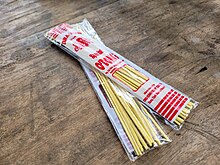  Top: Odong guisado Top: Odong guisadoBottom: Uncooked odong noodles | |
| Alternative names | Pancit odong, Udong, Pancit udong |
|---|---|
| Place of origin | Philippines |
| Region or state | Davao Region, Visayas |
| Serving temperature | Hot |
| Main ingredients | Flour noodles, canned sardines with tomato sauce, bottle gourd, loofah, other vegetables |
| Variations | Odong guisado |
Odong, also called pancit odong, is a Visayan noodle soup made with odong noodles, canned smoked sardines (tinapa) in tomato sauce, bottle gourd (upo), loofah (patola), chayote, ginger, garlic, red onions, and various other vegetables. It is garnished and spiced with black pepper, scallions, toasted garlic, calamansi, or labuyo chilis. The dish is usually prepared as a soup, but it can also be cooked with minimal water, in which case, it is known as odong guisado.
It is a common simple and cheap meal in Mindanao (particularly the Davao Region) and the Visayas Islands. It is almost always eaten with white rice, rarely on its own.
It is named after the round flour noodles called odong which are closest in texture and taste to the Okinawa soba. These noodles are characteristically sold dried into straight sticks around 6 to 8 in (15 to 20 cm) long. The name is derived from the Japanese udon noodles, although it does not use udon noodles or bear any resemblance to udon dishes. It originates from the Davao Region of Mindanao which had a large Japanese migrant community in the early 1900s. The odong noodles were previously locally manufactured by Okinawans, but modern odong noodles (which are distinctly yellowish) are imported from China. Because odong noodles are difficult to find in other regions, they can be substituted with other types of noodles; including misua, miki (egg noodles), udon, and even instant noodles.
See also
References
- Polistico, Edgie (2017). Philippine Food, Cooking, & Dining Dictionary. Anvil Publishing, Inc. ISBN 9786214200870.
- Polistico, Edgie (July 28, 2018). "Odong". Philippine Food Illustrated. Retrieved January 18, 2022.
- ^ Ramos, Ige (November 18, 2013). "Kumain at tumulong". Bandera. Retrieved January 18, 2022.
- "Odong, Sardinas at Patola a la MaiMai". Market Manila. November 15, 2006. Retrieved January 18, 2022.
- ^ "Odong Recipe". Panlasang Pinoy. November 15, 2013. Retrieved January 18, 2022.
- Ong, Kenneth Irvin (October 18, 2018). "For the love of Ligo Sardines". Edge Davao. Retrieved January 18, 2022.
- ^ "Sardines with Odong Noodles". Kusina ni Teds. June 2, 2019. Retrieved January 18, 2022.
- ^ Figueroa, Antonio V. (September 12, 2016). "US, Japan linguistic legacies". Edge Davao. No. 142. p. 9. Retrieved January 18, 2022.
- Goodman, Grant K. (1967). "Japanese Percentage of Participation in Davao Province Industries". Davao: A Case Study in Japanese-Philippine Relations. University of Kansas, Center for East Asian Studies. p. 26. hdl:1808/1195. Archived from the original on August 7, 2022.
External links
| Philippine soups | |
|---|---|
| |
| Noodles | |||||||||||||||||||||||||||||
|---|---|---|---|---|---|---|---|---|---|---|---|---|---|---|---|---|---|---|---|---|---|---|---|---|---|---|---|---|---|
| Variants |
| ||||||||||||||||||||||||||||
| Dishes |
| ||||||||||||||||||||||||||||
| Instant noodle brands | |||||||||||||||||||||||||||||
| List articles | |||||||||||||||||||||||||||||
| See also | |||||||||||||||||||||||||||||
| Soups | |
|---|---|
| Soups |
|
| Blood soups | |
| Bean soups |
|
| Cheese soups | |
| Cream and yogurt soups |
|
| Fruit soups | |
| Noodle soups |
|
| Nut soups | |
| Vegetable soups |
|
| See also | |
